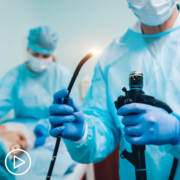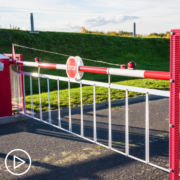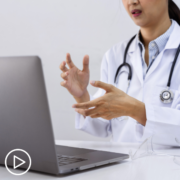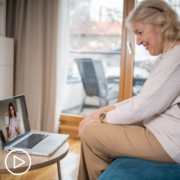How Can Myeloproliferative Neoplasm Patients Use Integrative Health? from Patient Empowerment Network on Vimeo.
How can myeloproliferative neoplasm (MPN) patients benefit from integrative health? Experts Dr. Krisstina Gowin, Dr. AnaMaria Lopez, and patient Lisa Hatfield discuss common symptoms of MPN patients, integrative health techniques, and benefits of including integrative medicine.
Download Resource Guide
See More from MPN TelemEDucation
Related Resources:
Transcript:
Lisa Hatfield:
So I have multiple myeloma, and, of course, that comes with side effects from the different therapies and symptoms of their own. We have a great integrative health center at our cancer center here locally where I live, and I’ve used it for acupuncture for some of my symptom management. I’ve also watched you on different platforms, through webinars and patient support groups where you describe different integrative health techniques and that type of thing. So I’m wondering…two questions. The first part is, what symptoms do MPN patients face the most? And then how can they use integrative health to do that, particularly as it relates to telemedicine? Are there telemedicine options for integrative health? I suppose things like acupuncture, maybe not, but other types of, of integrative health, and can they get a consult for integrative health? Can they even go as far as getting a consult? So if you can answer those questions, the symptoms they face, how to use integrative health, and if they can get a consult for integrative health, that would be great. We’d appreciate that.
Dr. Krisstina Gowin:
Yeah. Well, Lisa, I want to take a moment just to validate your journey that you’re going through and to congratulate you for your self-advocacy to go look for those integrative therapies to support yourself. And for MPN patients, I will say that it’s a really unique group, and so all cancer patients experience symptoms. But in myeloproliferative neoplasms, it’s really kind of this heterogeneous what we call a symptom burden. And so most patients will experience fatigue about 80 percent of MPN patients. But then beyond that, there’s really a whole slew of different sequelae that can be associated with the disease, which you may or may not think about when you’re thinking about MPNs, such as psychosocial issues, sleep issues, sexual issues.
And then we have kind of the classical issues that happen with MPNs, such as dizziness, but we talked about the fatigue, bone pain, itching, abdominal discomfort from an enlarged spleen and early satiety, or feeling full quickly. It’s really a huge symptom complex, if you will. And we now have validated measurement tools to better understand those. It’s the MPN symptom assessment form, which has really, I think, revolutionized how we look at MPN. It’s no longer just treating the blood counts. We’re treating the patient as a whole, and even within our NCCN guidelines, kind of how we as oncologists go through the algorithms of how to change therapy and how we look at patients. We now have symptoms in there. So even if blood counts are controlled, we may change therapies or even do a bone marrow based on symptoms alone. So symptoms are a huge thing in MPN. So getting to your second question for integrative health.
So I think that MPN…the patients in the community are really early adopters for digital engagement, which is fantastic. Everyone’s very engaged, and I’ve had the opportunity to work on meditation apps, yoga apps, a wellness-based app here from the University of Arizona, and patients just really accrue fast. Everyone’s so excited. And most of these, though, were very small kind of pilot trials, looking at feasibility, can’t we really do these things? But most of them as well are showing some impacts on depression, anxiety, sleep, and total symptom burden. So I do think that these modalities through digital platforms certainly can make a difference on the symptoms. And we’ve seen that with meditation. We’ve seen it with yoga, and we’ve seen it with a seven domain wellness app. And is it the digital engagement? I don’t think so.
I think it’s likely the integrative therapies that they’re receiving through that platform, right? We know meditation works, we know yoga works, perhaps not so well in MPNs. We need to build that evidence base, but other solid cancers, we know those interventions really work. But it’s wonderful to get that kind of early data, say it not only works, but it also works when you’re doing it at home, when you’re doing it on a digital platform. And so I would encourage all patients listening to this to, yes, look at what’s around you, what are the resources, what are the clinical trials? Looking at these different digital modalities for integrative medicine, but also to go get an integrative consultation.
And as Dr. Lopez already had mentioned, she does all of her integrative medicine via telemedicine now, which is fantastic. And so you, it’s really, it’s that, you know, your fingertips. You now have access to wonderful oncologists like Dr. Lopez to guide you in this journey. And the journey is not only allopathic Western medicine, but it’s treating you as a person, you as a whole symptom complex. And that’s really what integrative medicine aims to support you through.
Lisa Hatfield:
And you mentioned that Dr. Lopez also does her integrative health via telemedicine. So I’m going to ask, Dr. Lopez, can you speak to that a little bit more? How do you do that with patients? Do they just contact you and set up an appointment for an integrative health consult or appointment? And do you conduct some of that yourself, or do you send them to particular resources in the community?
Dr. AnaMaria Lopez:
Sure. So, yes, patients can make an integrative oncology appointment directly. I really like to do the consults through tele simply because I can…as I was mentioning, it’s like a virtual house call to really get a sense of the patient. Often a partner, significant other, caregiver might be present as well, and as we know there’s the survivor and there’s the co-survivor. So including both can be very helpful to some people, and I think the initial intake…again, as Dr. Gowin was saying, it depends so much on what the person wants to do. So the first opportunity for coming together is simply, “Where are you? What are your goals? What’s important to you? And of the panoply of options, which might be the easiest or the one that you are most interested in?”
And so depending on what it is, we might work together, we might also bring in others if the person is really interested in making lifestyle changes, let’s say related to nutrition. The person might work closely with a nutritionist for some period of time and then come back, and we’d come together and reassess. You mentioned the acupuncture, and you can’t do acupuncture at a distance, but you can certainly teach people about the points and consider acupressure for certain points. So there are so many ways to engage and interact, but yes, I think like a lot of medicine, it’s a team-based approach.
Share Your Feedback:
Create your own user feedback survey












